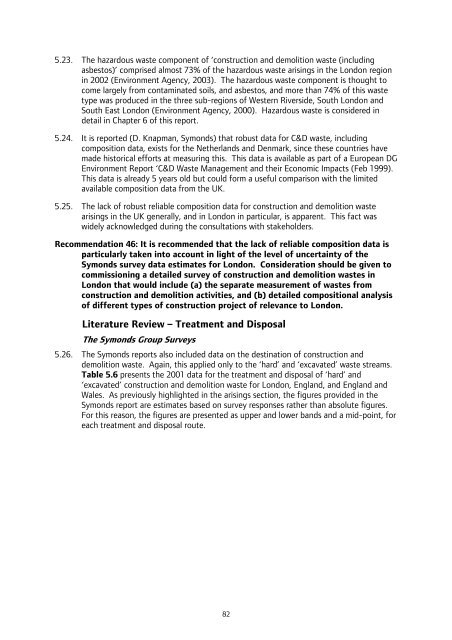London Wider Waste Strategy - London - Greater London Authority
London Wider Waste Strategy - London - Greater London Authority
London Wider Waste Strategy - London - Greater London Authority
Create successful ePaper yourself
Turn your PDF publications into a flip-book with our unique Google optimized e-Paper software.
5.23. The hazardous waste component of ‘construction and demolition waste (including<br />
asbestos)’ comprised almost 73% of the hazardous waste arisings in the <strong>London</strong> region<br />
in 2002 (Environment Agency, 2003). The hazardous waste component is thought to<br />
come largely from contaminated soils, and asbestos, and more than 74% of this waste<br />
type was produced in the three sub-regions of Western Riverside, South <strong>London</strong> and<br />
South East <strong>London</strong> (Environment Agency, 2000). Hazardous waste is considered in<br />
detail in Chapter 6 of this report.<br />
5.24. It is reported (D. Knapman, Symonds) that robust data for C&D waste, including<br />
composition data, exists for the Netherlands and Denmark, since these countries have<br />
made historical efforts at measuring this. This data is available as part of a European DG<br />
Environment Report ‘C&D <strong>Waste</strong> Management and their Economic Impacts (Feb 1999).<br />
This data is already 5 years old but could form a useful comparison with the limited<br />
available composition data from the UK.<br />
5.25. The lack of robust reliable composition data for construction and demolition waste<br />
arisings in the UK generally, and in <strong>London</strong> in particular, is apparent. This fact was<br />
widely acknowledged during the consultations with stakeholders.<br />
Recommendation 46: It is recommended that the lack of reliable composition data is<br />
particularly taken into account in light of the level of uncertainty of the<br />
Symonds survey data estimates for <strong>London</strong>. Consideration should be given to<br />
commissioning a detailed survey of construction and demolition wastes in<br />
<strong>London</strong> that would include (a) the separate measurement of wastes from<br />
construction and demolition activities, and (b) detailed compositional analysis<br />
of different types of construction project of relevance to <strong>London</strong>.<br />
Literature Review – Treatment and Disposal<br />
The Symonds Group Surveys<br />
5.26. The Symonds reports also included data on the destination of construction and<br />
demolition waste. Again, this applied only to the ‘hard’ and ‘excavated’ waste streams.<br />
Table 5.6 presents the 2001 data for the treatment and disposal of ‘hard’ and<br />
‘excavated’ construction and demolition waste for <strong>London</strong>, England, and England and<br />
Wales. As previously highlighted in the arisings section, the figures provided in the<br />
Symonds report are estimates based on survey responses rather than absolute figures.<br />
For this reason, the figures are presented as upper and lower bands and a mid-point, for<br />
each treatment and disposal route.<br />
82
















